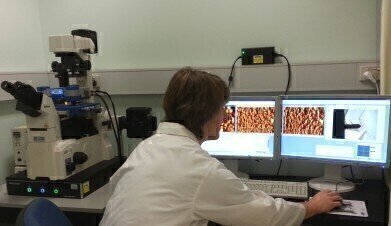Microscopy & Microtechniques
Versatile AFM System used for Force Measurements at Monash University
Jun 25 2014
Dr Rico Tabor leads the Soft Materials and Colloids Group in the School of Chemistry at Monash University. Research focuses on several areas. At a fundamental level, the group is interested in exploring the interactions that cause aggregation and assembly, in everything from nanoparticles, droplets and graphene to proteins and cells. In particular, they are exploring ways in which such forces can be exploited, such as whether changing something as simple as pH can cause particles or drops to coalesce or stick together. In other circumstances, more 'advanced' stimuli such as light or magnetic fields are used to induce the chemical or physical effects that are required.
Dr Tabor described some of the techniques that are used: “We use many tools frequently from simple things like surface tension all the way up to large-scale facilities such as the Australian Synchrotron and the neutron facilities at the Bragg Institute. However, AFM is the only technique that can tell us directly about forces in such a wide range of systems. Although there are other force measuring techniques, for the family of materials that we are interested in, AFM is the gold standard in terms of applicability, versatility and precision. With AFM, you can explore so much more. Some things such as biological molecules, surfactant assemblies and other soft, labile materials are almost impossible to image in electron microscopy, but with judicious cantilever choice, the AFM often comes to the rescue.”
So why did Dr Tabor choose the NanoWizard® AFM from JPK? “I have used several commercial AFMs but, for me, JPK AFMs appealed because of the durability when working in liquids - most of our systems are wet at one stage or another. We can just drop our sample into a Petri dish and off we go! The hassle of the fiddly liquid cells found with other AFMs used to frustrate me no end. The versatility of the JPK is a great bonus, and the setup time is so fast - I can be ready and imaging within 5 minutes, which I think beats any of the other comparable models. Combine this with automated force curve acquisition and analysis, and you have a powerful system for force measurement.”
Digital Edition
Lab Asia 31.2 April 2024
April 2024
In This Edition Chromatography Articles - Approaches to troubleshooting an SPE method for the analysis of oligonucleotides (pt i) - High-precision liquid flow processes demand full fluidic c...
View all digital editions
Events
Apr 17 2024 Tokyo, Japan
Apr 22 2024 Marrakech, Morroco
Making Pharmaceuticals Exhibition & Conference
Apr 23 2024 Coventry, UK
Apr 23 2024 Kintex, South Korea
Apr 23 2024 Seoul, South Korea









.jpg)








